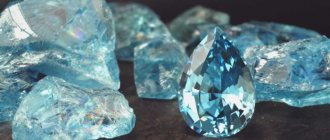Stones dancing, crawling, moving, walking, sliding - whatever they call an amazing phenomenon that has occupied the minds of geologists for more than a century! Why do the stones move in Death Valley? What natural or unnatural phenomena force them from time to time to move either along straight lines or along sharply changing trajectories? Why do some boulders, having made an amazing winding path, stop in place, while others disappear, leaving behind only a long, tattered trail?
Several generations of scientists have tried to answer these questions. Expeditions with the most modern equipment for their time were equipped to Death Valley more than once. Many hypotheses were put forward, some of which were confirmed and enshrined in dissertations. However, each time not only questions remained unanswered, but more and more new ones appeared.
The problem was resolved only recently during the next expedition, carried out in 2011-2013, when video cameras and GPS navigation sensors were used for observations.
Dry lake Racetrack Playa in Death Valley in the USA
This place has been attracting close attention for a long time. Many people want to see with their own eyes the ancient cobblestones that lie at the bottom of an ancient lake that has dried up.
It seems that such boulders should only be of interest to bearded geologists, but no. Considering that the unperturbed blocks move, everyone is curious about them. An irrefutable fact is that the human eye cannot detect movement. Because of this, scientists have put forward several theories as to why this happens. Explanations may be as follows:
- Earthquakes. Due to excessive seismic activity, the movement of stones occurs.
- Winds. They are very strong, especially in winter. True, many people understand that such a wind is not able to move a large block.
- Temperature fluctuations. During the daytime, the pebbles heat up and become larger. At night their volume decreases, mainly from the north.
- Dirt. With regular rains, the clay at the bottom of the lake gets wet. This can cause even large boulders to slide.
- Ice. After rainfalls, the water usually freezes. A thin ice crust appears, and the stones slide along this “skating rink”.
These are the main opinions. True, the moving stones clearly show that in fact they have a completely different nature.
Footprints
Moving stones leave grooves on the surface of the lake bottom. In most cases they remain visible for several years. The depth of the mark reaches 2.5 cm with a width of up to 30 cm in massive specimens.
Evidence suggests that the mass and size of “crawling” dolomite rock fragments are not significant. Both five-hundred-gram specimens and blocks weighing over three hundred kilograms moved.
During active research, during one period of activity, a six-centimeter (diameter) pebble traveled the maximum distance. He “crawled” more than 200 meters. The most massive specimen that showed activity during the same period weighed 36 kg.
The tracks left by ribbed stones are smoother. If the plane of the fragment is relatively smooth, then the groove most often “wiggles” from side to side. Some traces suggest that the stones were turned on their sides during the movement.
Blue stone in the Yaroslavl region
There is a village near Yaroslavl called Gorodishche. The village is ordinary, if not for one “but” - here one stone prefers to move independently. Scientists believe that the boulder was brought by a glacier. During sunny weather it has a gray color. But after the rain passes, the stone turns blue. The ancient block has been moving from place to place since the times of the ancient pagans.
After Christianity came to Rus', the church, with varying degrees of success, tried to get rid of paganism and declared the quick lump “the spawn of demons.” After this she was immediately thrown down the hill. But the majority of the Slavs were not going to part with the faith of their ancestors. People believed that the pagan gods would not just leave the sacred place.
The priests had no choice but to bury the boulder in the ground. But the Blue Stone appeared on the surface after 15 years. Experts explain this by saying that water erosion eroded the slope and the soil pulled the stone to the surface. After this, worship of the boulder resumed.
Later they tried to transport the stone, but it fell to the bottom of Lake Pleshcheevo - so the Blue Stone ended up in its original place after half a century. He continues to move to this day.
Myths and hypotheses
The desert, where the stones move, apart from this geological phenomenon, has no other obvious deviations from the norm. True, in the mountains surrounding the valley, there was once a volcanic eruption, which left a crater more than a kilometer wide. But this happened several thousand years ago.
How to explain the phenomenon of independently moving stones? There are supporters of the mystical theory. Some people who visited Death Valley reported some discomfort, but it is difficult to pinpoint the cause. Whether this is related to geomagnetic fields is unknown.
There is also a theory that each stone contains a certain essence that cannot be explained scientifically. A group of scientists studying not only this phenomenon suggests that the moving stones are manifestations of another, more ancient silicon life form.
The Valley of Death is not spared by myths about aliens and the tricks of evil spirits. Since the beginning of research into the phenomenon, hypotheses have been put forward about seismic activity in the region and the impact of complex geomagnetic fields.
In general, there is room for imagination. Anyone can choose a suitable theory as a basis and try to prove or disprove it after a visit to the valley. The mystery that is still present attracts not only tourist travelers, but also scientists to these places. It is believed that the area where such phenomena occur is part of anomalous zones, and there are always plenty of supporters to tickle their nerves.
Other stones
Other silent huge blocks are also moving. Some of them are widely known, others are known only to a few.
- Ancient Buddha stone. There is a monastery in Tibet. His followers have been watching him for 15 centuries. It is believed that Buddha himself left his fingerprints on the boulder. The boulder weighs more than a ton. It is assumed that its age is about 50 million years. Its main feature is that it is able to crawl. It takes him 60 years to complete one circle around the monastery.
- Crawling stones of the Valley of Ghosts. They are located on Mount Demerzhi. Interestingly, a number of boulders are capable of moving at great speed.
- Tree-climbing stones. There are boulders in Kingston that inexplicably end up on trees.
- Rocks on other cosmic bodies. It turns out that they are not only on Earth. For example, on one of the craters of the Moon, boulders were seen that moved and left a mark.
Solution
The issue was clarified quite recently. The next experiment was launched in 2011 by physicists from Hopkins University under the leadership of planetary scientist Ralph Lorenz. Traditionally, stones were selected (15 pieces). All of them were initially placed in the southern part of the valley, since all movements begin in this area. A GPS navigation sensor was attached to each boulder and continuous video surveillance was organized.
In the first two years, not a single stone was moved. And only in the winter of 2013 did the movement begin. This year, a cyclone of rare power visited the Racetrack Playa area. It brought a huge amount of precipitation in the form of rain and snow, and at night it all froze. The bottom was covered with an ice crust only 3-5 mm thick. But the ice did not remain a single piece, but split into slabs, each of which contained a frozen boulder, and the stones moved. The speed was 5 m/min. Everything was recorded on camera. Over two winter months (December and January), some stones covered 225 m.
Now everything has become clear. In order for the boulders to move, a number of circumstances must come together. In one of the driest and hottest places on earth, you should:
- heavy precipitation in winter;
- the temperature drops sharply below zero;
- a strong wind will blow, which will help crack the ice and move the stones out of place.
Such conditions can only arise at the dawn of a frosty winter night, because when the first rays of the sun appear, the ice will melt and movement will stop.
The curvature of the trajectories and the sharp change in directions of movement were explained by collisions of boulders with each other and changes in wind speed. Everything turned out to be very simple. They even answered the question of where some of the displaced boulders disappear to. It turned out that the absence of a stone at the end of the path indicates that the moving one was an ice floe that simply melted. Thus, the main question of why the stones move in Death Valley, as well as a number of related ones, was put to rest.
Paula Messina and her research
Professor Paula Messina studied geological and atmospheric phenomena to understand the nature of "living" cobblestones. In 1993, the girl defended her dissertation on the topic of moving stones. She tested old ideas using a GPS system that allowed her to accurately track the position of the stones.
The professor realized that blocks most often do not move along parallel lines. Because of this, the idea that ice was involved was rejected. Paula tracked the coordinates of more than 150 objects.
Paula Messina proved that sliding processes are not affected by size or shape. But it is important in which part of the lake bottom the stones are located.
A model of a wind rose over the lake was created. But in the end it turned out to be quite difficult due to the mountains surrounding it. The wind splits into several streams when there is a storm. Stones that are located at opposite ends of the reservoir move in different directions. The wind streams collide in the very center of the lake and twist into a small tornado. He is able to spin boulders.
It turned out that during independent movement the stones are affected by several vortices. Situations arise when they are in the center of a hurricane. Now, since 1993, Professor Messina has been monitoring the situation. However, the woman is still unable to answer some questions. Why do some objects lie calmly in place, while others stubbornly move? For what reason do wind currents drive cobblestones to certain places, and over time they end up in another area? Do people have anything to do with the movement of blocks?
History: Valley of the Moving Stones (California)
It is believed that a thousand years ago this territory and the entire Mojave Desert were inhabited by the Timbisha Indian tribes. There are suggestions that their descendants still live in the vicinity of the valley. Then the climate in the region was not so harsh, and the Indians could survive by hunting and gathering. The tribes left and were replaced by others, but the stones remained.
The first settlers from Europe appeared in California with the beginning of the gold rush. There is information that in 1849, prospectors decided to drive through the territory of the current valley in order to shorten their path to the nearest gold mines. For several weeks they wandered around the plateau, looking for a way out. They had to endure serious trials, because they did not know about the harsh climate of the territory. When they crossed the Wingate Pass Mountains, the area they crossed was called Death Valley. Along the way, in order to survive, the miners had to look for water by digging up dry streams and feed on their pack animals.
For the first time in the history of the phenomenon, the movement of stones was captured on camera in time-lapse mode.
The first scientific observation recorded on a time-lapse camera was made between December 2013 and January 2014. Scientists report that the movement process occurs when thin ice, 3 to 6 mm thick, begins to melt under the sun's rays and breaks into pieces. Floating ice plates, separated from the total mass of ice with a linear size of 10 or more meters in a weak wind of 4-5 m/sec, push the stones, forcing them to move at speeds of 2-5 meters per minute. The movement occurs along trajectories determined by the direction of the wind and its speed, which quite easily explains the variety of trajectories of stone movement.
The solution to the mystery of moving stones, which scientists have been struggling with for several decades, turned out to be quite simple: wind and ice. And no mysticism or mysterious UFOs. The video below, starting from frame 2.58, shows for the first time the movement of a stone under the influence of a moving ice crust on Racetrack Playa! There is no more mystery.
The most mysterious stones of our planet (video)
Death Valley still attracts scientists. Science still has to answer a number of questions. For example, why do some boulders move great distances every winter while others remain in place for years? Can this be explained by the fact that the bottom of a dry lake is moistened unevenly? Also, recent studies have not yet explained why the valley is covered with stones evenly, whereas due to regular winds, the bulk of them should be concentrated along the perimeter of Racetrack Playa.
It's worth noting that Death Valley is not the only place where moving boulders can be found. A similar geological phenomenon is observed in southern Romania, as well as on the Moon and Mars.
Official version
Until recently, it was believed that moving rocks were the result of a unique combination and interaction of clay soil, water, wind and ice. It was not possible to establish which of the elements plays a decisive role and which plays an auxiliary role.
Presumably in winter, when the greatest physical activity occurs, the soil of the lake bottom is in a wet state due to the presence of precipitation during this period. Soaked clay soil has a low coefficient of friction. Sliding is also affected by frost on the surface of stones and temperature changes.
Gusts of wind, which sometimes reach high speeds and have turbulence similar to the effect of a tornado, can trigger the onset of movement. The unevenness, chaotic directions of the vectors, as well as the unpredictability of the onset of activity may be a consequence of the unique coincidence of wind strength, humidity and temperature conditions.
Is this phenomenon explained from a scientific point of view?
For a long time, scientists have been trying to unravel the mystery of moving boulders. Currently there are 3 hypotheses:
- The stones move due to rainfall. From time to time, heavy rains occur in Death Valley, which turns its desert surface into a clay swamp. Scientists suggest that the slippery clay mass is an excellent basis on which stones, driven by the wind, begin to roll. However, this theory does not explain how large specimens weighing more than 200 kg can move.
- Strong wind. There is an assumption that the stones are moved by the wind. However, there is no confirmation of this theory. Scientists have calculated that to push stones, the wind speed must reach several tens of kilometers per minute.
- A magnetic field. In the 20th century, there was an assumption that in Death Valley there is a special magnetic zone that affects all objects and makes them move. However, the study of the magnetic field on this plateau did not produce any results.
- An ice crust on which heavy stone blocks slide. This theory is one of the most probable today. Scientists theorize that during cold times, a thin crust of ice forms under the stones, allowing them to slide on the clay surface.
Salt marshes
Death Valley National Park (California) is extremely rich in minerals - there are deposits of borax, talc, borates, and silver.
Over the years they tried to mine copper, gold and lead. And also extremely high in salt. In the only reservoir in Death Valley, the water is four times saltier than in the ocean, and around you you can see amazingly beautiful salt deposits.
The salt marshes here divide the area into two completely different zones:
- Devil's Golf Course. Salt crystals in one of them grow with their tip upwards and form amazing-looking pointed structures and labyrinths almost a meter high. It is very difficult to move here, and even impossible without special shoes. During the day, during the heat, the crystals produce a rather ominous sound, unlike anything else.
- Badwater. It is this territory that is located 86 meters below the level of the World Ocean. Here the salt marshes look different. On a completely smooth plain, a grid is formed that looks like hexagonal figures, and from the heights of the mountains, a magnificent, unreal, fabulous view opens up before tourists.
Research by Californian scientists
In the spring of 1972, Robert Sharp and Dwight Carey began a program to monitor boulder movements. For this purpose, 30 blocks with fresh traces were selected, each of which was given a name. The researchers used stakes to indicate their initial position. It took scientists about 7 years to formulate their theory. It was as follows:
- During the rainy season, water accumulates in the southern part of Racetrack Playa.
- The wind carries moisture along the bottom of a dry lake.
- Clay soil gets very wet.
- Since the friction force has decreased significantly, the wind blows away even the largest blocks weighing more than 300 kg.
This study also tested the idea that ice moves rocks. On winter nights, the temperature in the valley can sometimes be below zero. Then the water, driven by air masses, becomes covered with a layer of ice, into which the boulders freeze.
Everything ingenious is simple: wind and ice move stones!
In 1955, George Stanley, an employee of the University of Michigan, suggested that such a crust of ice contributes to the movement of multi-kilogram stones. Thus, the main logical message of Stanley's work - the influence of wind and seasonal changes - sets the direction for finding the right answer to the riddle of Death Valley.
Stones moving along parallel trajectories - Lake Racetrack Playa
In 2011, a team of researchers at the Scripps Institution of Oceanography in San Diego set out to solve the mystery, determined to do so. In winter, in December 2011, they brought to Racetrack Playa a whole weather station to measure wind speed and GPS sensors, which they planned to build into the stones, which would allow them to constantly monitor their movements. However, the US National Park Service prohibited them from using natural stones for this purpose, citing the expediency of preserving the reserve in its original state. This did not stop the resourceful young people, and they brought with them 15 heavy cobblestones with GPS sensors already built into them and prepared to wait.
Luck “smiled” in December 2103, when study co-authors Richard and Jim Norris visited Racetrack Playa again to conduct observations. On December 21, around noon, they heard the sounds of cracking ice melting under the rays of the sun. The ice broke into large pieces-plates, which, under the influence of the wind blowing at a speed of 3-5 meters per second, began to move. Colliding with stones, the ice plates moved them tens of meters! But why had no one ever observed the movement of stones before? To this Jim replies that in reality it is difficult to detect the movement of stones, being at some distance from them, when the speed of movement of the stones is only 5-7 cm/sec. and provided that the neighboring stones also move. In addition, the probability of getting exactly at the time when this phenomenon can occur is quite small. “We documented five movement events over two and a half months until a thin layer of water evaporated from the pond,” said Richard Norris.











